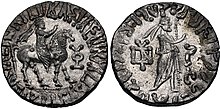|
Abdagases I
Abdagases I (Greek: Ἀβδαγάσης, epigraphically ΑΒΔΑΓΑΣΟΥ; Kharosthi: 𐨀𐨬𐨡𐨒𐨮 A-va-da-ga-ṣa, Avadagaṣa[1][2]) was an Indo-Parthian king, who ruled Gandhara and possibly over most of the Indus region from c. 46 to 60 AD. He was a nephew and successor of Gondophares, who had laid foundations for the Indo-Parthian kingdom after revolting against his Arsacid overlords in c. 19 AD.[3] Abdagases was succeeded by Orthaghnes or Pacores.[1] LifeAbdagases belonged to the House of Suren, [citation needed] a prominent and influential family within the Arsacid Empire. He succeeded his uncle Gondophares as the ruler of Gandhara in c. 46 AD, whilst Orthagnes succeeded him at Drangiana and Arachosia.[4] The figure of Abdagases is obscure; according to Gazerani, it is likely that Abdagases may have been the same person as another Abdagases,[5] an influential and powerful Suren noble in the Arsacid Empire, who belonged to a faction of Parthian magnates that were dissatisfied with the Parthian king Artabanus II. The Parthian magnates had at first favoured a grandson of Phraates IV, also named Phraates as a better choice for king. However, he met an abrupt death in Syria.[3] The Parthian magnates then turned to another prince, Tiridates III, who was crowned by Abdagases.[6] Some of the Parthian magnates, however, were supporters of Artabanus II, due to their concern that Abdagases would become the de facto ruler of the Arsacid Empire, with Tiridates as a figurehead.[6] As a result, Abdagases and his son Sinnacus withdrew their support from Tiridates as well.[6] This event seems to have coincided with the declaration of independence in Sakastan by the Suren family under Gondophares.[6] The identification of the two Abdagases figures, although supported by some scholars, nevertheless still remains indecisive, due to the lack of numismatic evidence.[6] Abdagases ruled as king till c. 60 AD, and was succeeded by Orthagnes or Pacores.[1] Notes^ a: The faith of the House of Suren remains uninvestigated in current scholarship. Pourshariati has suggested a faith based on the worship of Mithra being practiced by some of the Parthian families.[7] References
Sources
External links
|
||||||||||||||||||||
Portal di Ensiklopedia Dunia
